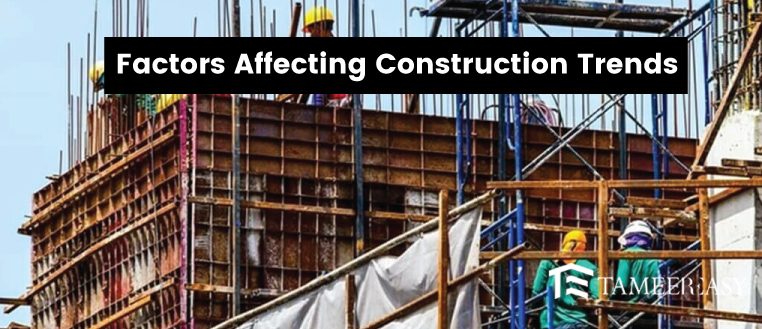Introduction
Pakistan’s construction sector has undergone tremendous expansion and change in recent years. This industry is essential to the growth of the nation’s economy since it generates jobs and helps to build infrastructure.
This essay will examine the major elements influencing Pakistan’s construction market and their potential influence on emerging trends. Professionals in the sector, investors, and policymakers must understand the variables affecting Pakistan Smart construction techniques trends.
1). Economic Conditions
The state of the economy is one of the main variables affecting construction patterns in Pakistan. Economic stability, GDP growth, and government spending on infrastructure projects significantly impact the construction business.
In times of economic expansion, there is a rise in building investment, which results in the creation of residential, commercial, and public infrastructure projects. On the other hand, economic downturns can slow down construction work and cause priorities to change.
2). Government Policies and Initiatives
Government efforts and policies greatly influence the development of Pakistan’s building industry. The government’s emphasis directly impacts construction trends on housing initiatives, infrastructure development, and urbanisation projects.
Tax incentives, business-friendly changes, and regulatory frameworks for the construction sector are policies that can draw in domestic and foreign capital, fostering innovation and growth.
3). Population Growth and Urbanization
Pakistan’s population is quickly expanding, and many people live in cities. Due to this demographic change, demand for homes, businesses, and urban infrastructure has skyrocketed. Construction firms, architects, and developers have more options due to the increase in urbanisation to suit the expanding needs of city residents.
The development trends seen in metropolitan regions are influenced by shifting lifestyles, migration patterns, and the concentration of economic activity in cities.
4). Infrastructure Development
Pakistan’s construction trends are significantly influenced by investment in infrastructure development. The government is building roads, bridges, airports, ports, and energy projects to improve connectivity, boost trade, and draw in foreign investment.
Large-scale infrastructure projects increase demand for building supplies, labour, and the materials that go into them.
5). Technological Advancements
The building sector has revolutionised worldwide, and Pakistan is no different. Technology is anticipated to significantly impact Pakistan’s construction trends as it becomes more widely available and reasonably priced.
Introducing new construction methods, 3D printing, automation, and building information modelling (BIM) can change the sector. These innovations accelerate project delivery times, increase efficiency, and save costs.
6). Environmental Considerations
Green building techniques have become more prevalent in Pakistan since there is a growing understanding of environmental sustainability. Construction trends are influenced by climate change, resource conservation, and energy efficiency.
Eco-friendly materials, energy-saving construction techniques, and renewable energy sources are used increasingly frequently. Regulatory mandates and certification programmes that support green buildings also impact construction practices and trends.
7). Foreign Direct Investment (FDI)
FDI has the potential to impact Pakistan’s construction patterns considerably. The country attracts foreign investors looking for possibilities in the construction sector due to its advantageous location, expanding economy, and investment-friendly legislation.
Collaborations between domestic and foreign construction companies offer the industry new technology, knowledge, and funding, fostering innovation and adopting global best practices.
8). Social and Cultural Factors
In Pakistan, social and cultural aspects also influence construction trends. Architectural styles, artistic legacy, and local tastes all impact the design and appearance of buildings.
Cultural norms and societal demands affect the desire for particular housing types, communal areas, and public infrastructure—additionally, demographic changes like the growing middle-class impact building styles and the need for contemporary facilities.
Conclusion
Various factors, including economic conditions, governmental policies and initiatives, population growth and urbanisation, infrastructure development, technological advancements, environmental considerations, foreign direct investment, and social and cultural factors, impact the construction industry in Pakistan. These elements influence national construction trends and offer helpful information to investors, businesspeople, and legislators.
It’s essential to comprehend these factors to stay current on Pakistan’s changing construction scene. Professionals in the industry can use this information to align their plans, look for new possibilities, and adjust to shifting market dynamics. Investors can make wise selections by considering current economic conditions, governmental regulations, and infrastructure development plans.


